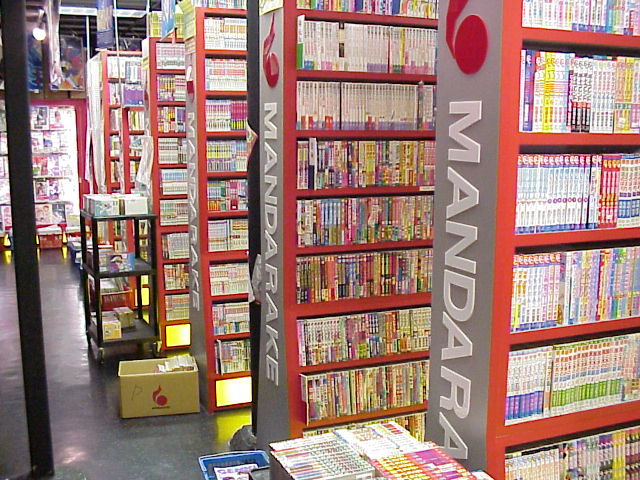
Where can I buy old anime cels?
Anime produced from the late 1990s to the present are computer-animated, so hardly any animation cels have been produced since then (which is why cel-only shops disappear: not enough stock available to flow in). Thus, you are generally looking for pre-owned cels that a previous collector has re-sold to a used goods shop.
Where to buy anime products in Tokyo?
Animate is Japan’s largest retail chain for anime goods and it has several locations open in Tokyo. Whether you’re a fan, or you’re just getting started with the anime culture, this is a great place to visit.
What size are anime cels?
Welcome to my collection of Anime cels collected over the last 25 years. All cels are original production cels used in the making of the movies and t.v. shows and standard size 10 1/2″x9 1/2″ unless noted in the description. Descriptions are as accurate as possible, please contact me if you have any questions or want more details.
Where can I buy manga in Japan?
With several locations in Tokyo, Jump Shop has become a popular name among anime and manga fans both inside and outside of Japan. They sell anything from DVDs, stationery, illustrations, accessories, and sundries, totaling over 3,000 different items.

Can you buy anime cels?
With FROM JAPAN you can easily bid on anime cels in real time or buy directly from collectors.
How do you store anime cels?
Display your framed animation cels with care. The gum-arabic paints used to create many of these cels are sensitive to temperature and humidity. Never display them in direct sunlight. We recommend hanging your framed cels on a cool, dry, inside wall that is not subject to temperature changes.
What are cels in anime?
Cels (or celluloid) are painting on transparent plastic sheet used to create an animation. Each cel is one "frame". They are filmed and then put behind one another to give the illusion of a continuous motion.
Is cel-Ga legit?
Cel-ga.com is part of the Japanese Gallery. Based in Kensington Church Street it was established 1977 and is one of the leading Japanese antique dealers in the UK, selling original ukiyo-e woodblock prints, ceramics, antique swords amongst other items.
Does anime still use cels?
According to the Association of Japanese Animation, Sazae-san was the only anime remaining on the air that used hand-drawn cel animation, and with it changing to digital, there will be none left.
Is cel animation still used today?
Traditional cel animations may have been replaced by CGI and other digital animation techniques, but you can still create a cel animation today.
What was the last cel animated anime?
The last animated feature that appeared in the theatres was peter pan 2, before that the only one I can remember was Atlantis, but someone else probably knows better than me.
What are the disadvantages of cel animation?
1 Time Consuming. Animators draw individual frames for each scene. ... 2 Correcting mistakes. A mistake in traditional animation requires you to repeat the whole drawing instead of deleting and correcting a mistake. ... 3 Costs. Traditional animation requires a numbers of tools and equipment per production. ... 4 Lack of a market.
How were anime cels painted?
Following a planning process, animators transfer draft drawings onto transparent sheets of plastic called cels. Each cel features one drawing with an outline on one side of the plastic and the color is filled in on the other. These 'cels' are then placed over a background and photographed in sequence.
What is an anime douga?
Douga. Most cels you buy come with the corresponding production sketch, or 'douga' in Japanese, stuck on the back. Artists refer to a douga to paint the exact frame needed – the different colours on the sketch denote the levels of shading and differentiate parts of the subject.
Auction Houses
- Comic Connect (https://comicconnect.com)
- Easy Live Auction (https://www.easyliveauction.com/)
- eBay (www.ebay.com): probably the most active marketplace in the US for anime cels. Buyer beware!]
- Heritage Auctions (www.ha.com): the largest US auction house that routinely auctions anim…
- Comic Connect (https://comicconnect.com)
- Easy Live Auction (https://www.easyliveauction.com/)
- eBay (www.ebay.com): probably the most active marketplace in the US for anime cels. Buyer beware!]
- Heritage Auctions (www.ha.com): the largest US auction house that routinely auctions anime cels. You pay a lot but can access some of the highest quality cels on the market.
Anime Dealers, Professional Galleries and Marketplaces
- Akihabra Art Gallery (https://www.akihabara-art.com/)
- Animation Art Gallery (https://www.animationartgallery.com)
- Animation Legends (www.animationlegends.com): varied collection with occasional drops of anime.
- Anime Cels (https://animecels.net)still active apparently but not well categorized.
Marketplaces
- Craigslist (https://craigslist.com)
- Facebook Marketplace(https://facebook.com)
- TodoColeccion (https://en.todocoleccion.net/) Spanish auction house, never ordered from it and may require an intermediary.
Western Animation Dealers & Professional Galleries
- Animation Sensations https://www.animationsensations.com/
- Charles Scott Gallery https://charlesscottgallery.com
- Silver K Galleries http://www.silverkgallery.com.au
- Celbase https://celbase.com
Popular Posts:
- 1. how to download anime with subtitles
- 2. how to find anime to watch
- 3. how to put anime in english on crunchyroll
- 4. how to block anime on youtube
- 5. what anime is houtarou oreki from
- 6. where to buy anime things
- 7. how to draw a fist anime
- 8. a anime wizard
- 9. where can i watch free anime
- 10. does crunchyroll have funimation anime